市场资讯及洞察
.jpg)
Bitcoin has now outlasted the peak of all its previous four-year cycles.
For over a decade, every Bitcoin cycle has followed the same sequence: consolidation, breakout, mania, crash. Rinse and repeat.
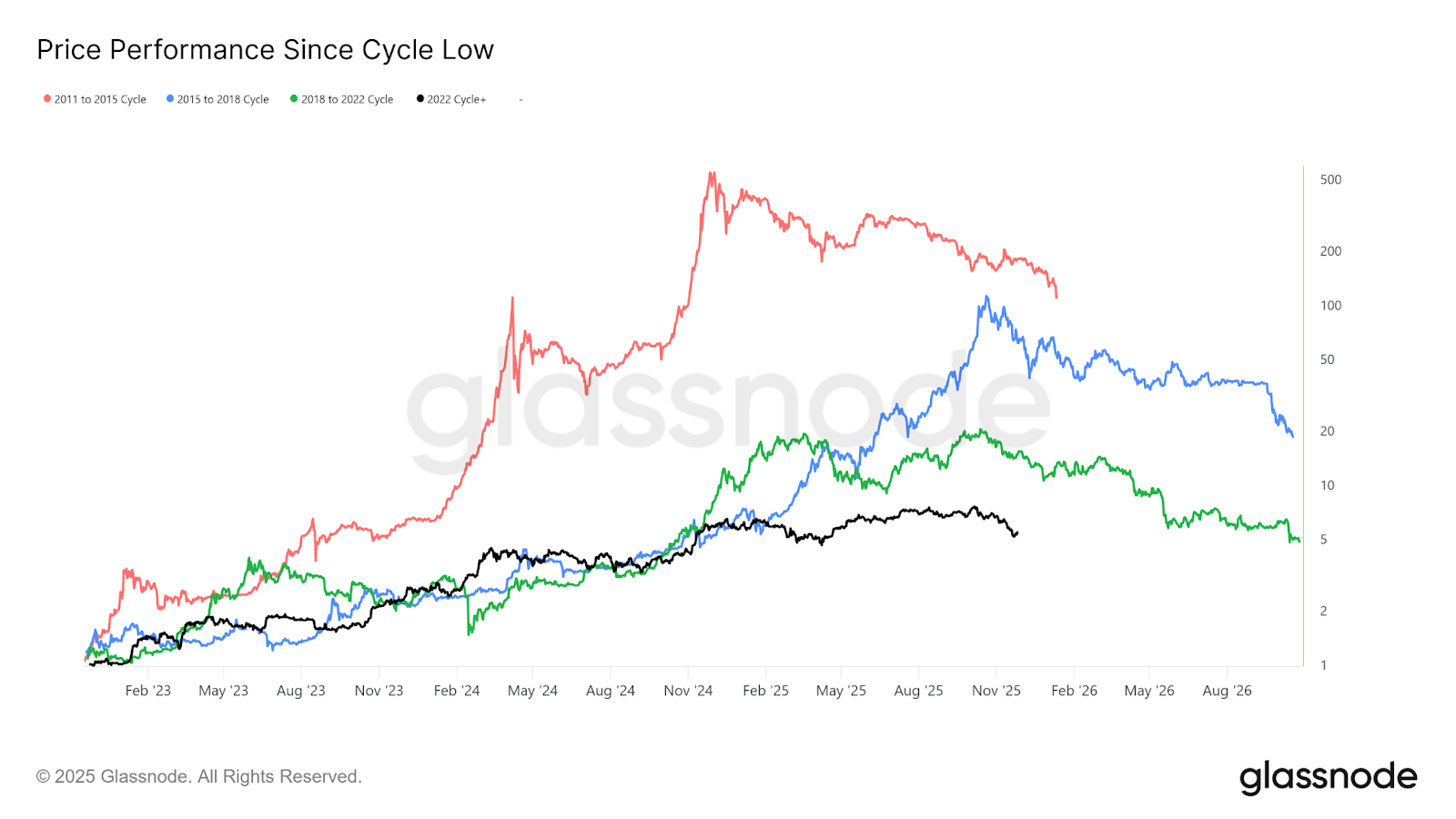
Timeline-wise, we should be at the post-mania inflection point, waiting for the seemingly inevitable crash.
Yet unlike previous runs, this cycle never saw its “mania phase.” Instead, Bitcoin has spent the past year grinding sideways, touching new all-time highs without a euphoric blow-off top that defined previous cycles.
The fact that this euphoria period never materialised brings into question whether this cycle still has room to run, or has the market simply matured past the point of mania-driven peaks?
The Historical Four-Year Pattern
The traditional Bitcoin cycle was simple. Every four years, a halving event would reduce the block reward (amount of new Bitcoin being created) by half, creating a supply shock that triggered major bull markets.
The 2013 cycle, the 2017 cycle, and the 2021 cycle all followed this script. Each halving was followed by a 3-to 9-month growth period, then a full-on mania period, before topping out 12 to 18 months after the event.
Following the most recent halving in April 2024, Bitcoin experienced five months of sideways consolidation, then hinted at making its anticipated breakout into mania after the US election… but quickly returned to sideways consolidation for the next year.
We have seen new ATHs and the price has made some notable gains during the period, but the overall momentum has been much weaker.
This failure to repeat the frenzies of the past three cycles has brought into question how much influence the Bitcoin halving truly has on the market anymore.
No Longer a Supply Shock
In previous cycles, the halving created a situation where prices had to rise to clear the same dollar amount of miner expenses (who were now earning half the Bitcoin).
Bitcoin miners would simply not sell until the price reached a certain level, creating a supply shock that would drive prices higher.

Miners still do this today; however, the market’s maturation and the institutional adoption of Bitcoin have dampened the impact.
Selling off Bitcoin is no longer a balancing act where miners hold influence over price. The market has deep liquidity that can handle significant flows in either direction.
Institutional ETFs routinely purchase more Bitcoin in a single day than miners produce in a month.
The supply reduction that once drove dramatic price movements is now easily absorbed by a market with institutional buyers providing constant demand.
If the Halving Isn't Driving Cycles, What Is?
The overriding narrative is that the Bitcoin cycle is now tied to the global liquidity cycle.
If you plot the Global M2 Money Supply versus Bitcoin on a year-on-year basis, you can see that every Bitcoin top has correlated with the peaks of Global M2 liquidity growth.
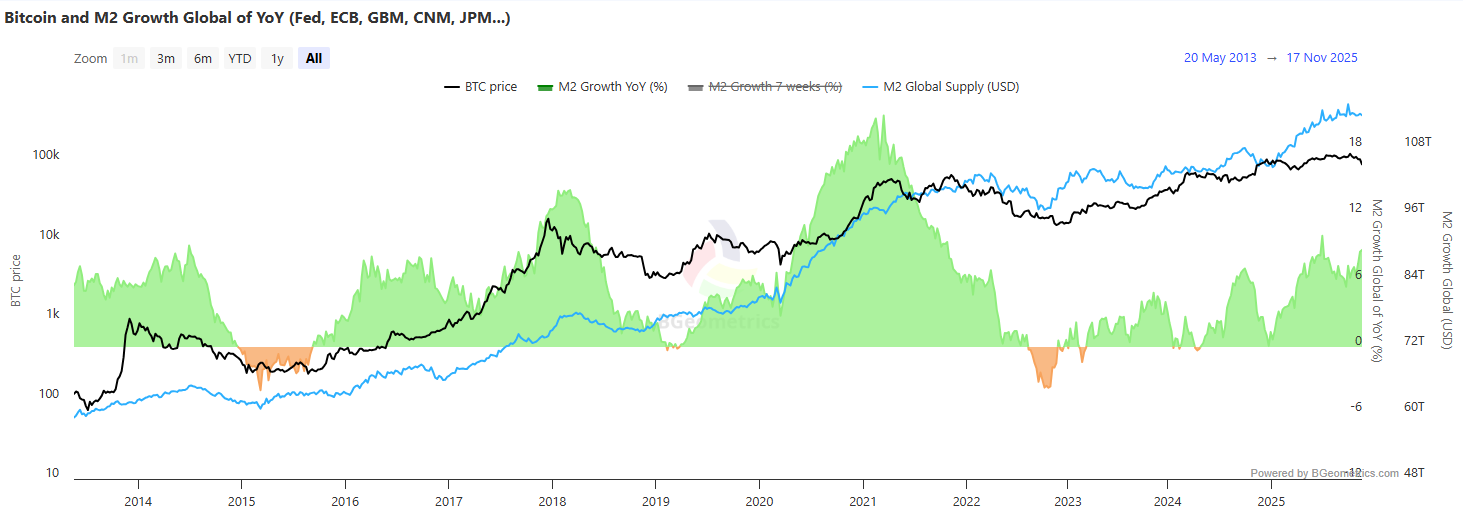
This isn't unique to Bitcoin. The Gold price has closely mirrored the rate of Global M2 expansion for decades.
When central banks flood the system with liquidity, capital tends to move into stores of value or high-risk assets. When they drain liquidity, those same assets tend to retreat.
However, this is a correlation; these relationships may change and should not be relied upon as indicators of future performance.
Is the Dollar Just Getting Weaker?
The U.S. Dollar Strength Index tells the other side of this liquidity story. Bitcoin versus the dollar year-on-year has been almost perfectly inversely correlated.
Simply put, as fiat currencies lose purchasing power, “hard” assets like Bitcoin and Gold start to appreciate. Not because of improved fundamentals, but because the currencies they are paired against are simply worth less.

The Self-Fulfilling Prophecy
Beyond the charts and patterns, there is also the psychological notion that the four-year cycle persists precisely because people believe it will.
People have been conditioned by three complete cycles to expect Bitcoin to peak somewhere between 400 and 600 days after a halving.
This collective belief shapes behaviour: traders take profits, investors take fewer risks, and retail enthusiasm wanes. The prophecy fulfils itself.
When everyone believes Bitcoin should peak 18 months after a halving, the combined selling pressure can create exactly that outcome — regardless of whether the underlying driver still exists.
The current market weakness, with Bitcoin dropping over 20% from its October record high, occurred almost precisely at this 18-month mark.
Is This Cycle Built Different?
Despite this on-cue sell-off, this cycle still has the potential to break away from the historical four-year pattern.
Increased ETF adoption by institutional investors has brought in higher quality and consistent ownership of Bitcoin.
Unlike retail traders, who often panic-sell during corrections, institutional holders tend to maintain their positions through volatility.
For example, Michael Saylor’s high-profile MicroStrategy fund has continued to purchase Bitcoin through market weakness. Recently reporting a purchase of 8,178 BTC at an average price of $102,171.
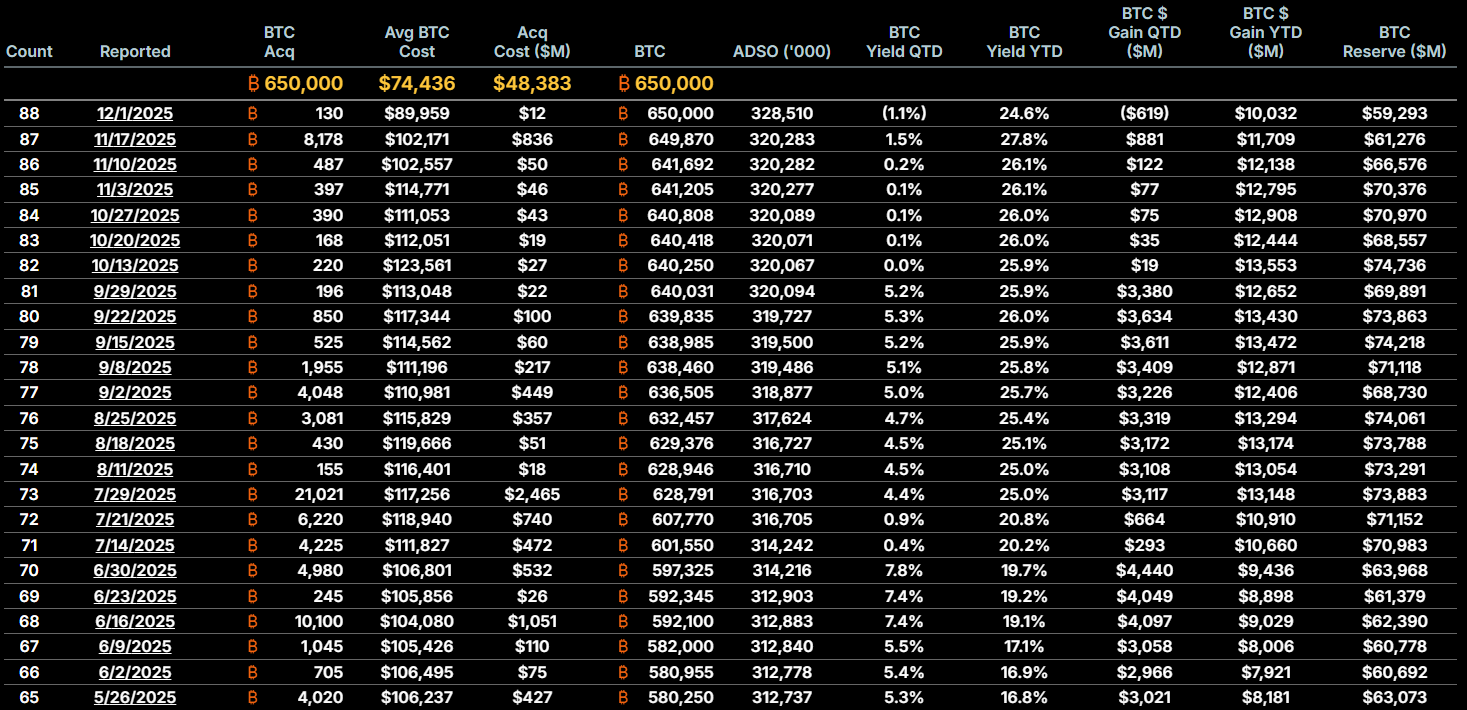
Another hard indicator that diverges from previous cycle peaks is the amount of Bitcoin being held on centralised exchanges.
The current amount of BTC on CEXs is unusually low. This pattern is generally seen closer to cycle lows, rather than peaks.
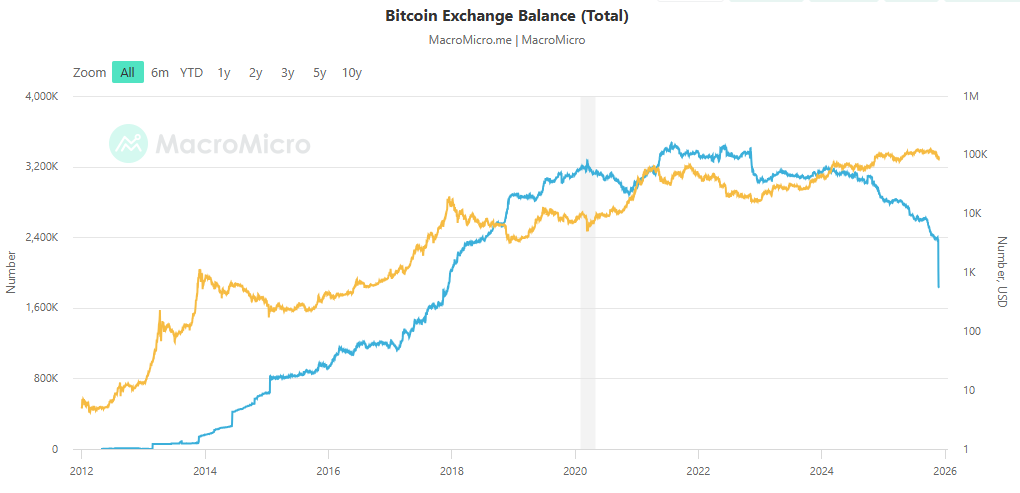
Other factors supporting the break of the four-year mould are coming out of the Whitehouse.
A comprehensive regulatory framework through the CLARITY Act represents structural changes and boundaries for regulatory bodies that didn't exist in previous cycles.
And the move to establish a Strategic Bitcoin Reserve will see all government-held forfeited Bitcoin (approximately $30 billion worth) transferred into a government reserve, signalling Bitcoin as a strategic asset like Gold and oil.

Bitcoin Has Finally Grown Up
The four-year cycle has been a useful heuristic, but heuristics break down when conditions change. Institutional buyers, regulatory clarity, and strategic reserves represent genuinely new conditions historical patterns don’t account for.
At the same time, dismissing the cycle entirely would be premature. The self-fulfilling aspect means it retains predictive power even if the original cause has weakened.
Market participants act on the pattern they've learned, and their actions create the pattern they expect.
Perhaps the real insight is that the Bitcoin market cycles never had just one cause. They were always the result of multiple overlapping forces — programmed scarcity, liquidity conditions, sentiment, self-reinforcing expectations.
The cycle shifts character as some forces strengthen and others weaken. But whether the forces have shifted enough to break the four-year trend is yet to be determined.
The fundamental indicators show this cycle may have some life, but the psychological power of the four-year pattern could push it to another, predictable end.
You can trade BTC and other popular Crypto CFD pairs on GO Markets with $0 swaps until 31 December 2025.
.jpg)

随着人工智能(AI)技术的飞速发展,AI 炒股逐渐成为一个备受关注的热门话题。AI不再仅仅是科研工具,而是开始在金融市场中扮演重要角色。
在人工智能与金融结合的大潮下,Alpha Arena 和 RockFlow 分别以不同方式探索 AI 在投资交易中的应用。Alpha Arena 是一个开源加密货币交易竞赛,由 Nof1.ai 发起。平台将多个顶级大语言模型(如 GPT-5、Claude、Gemini、Grok 等)赋予真实资金,在去中心化永续合约市场中自主交易。每个模型完全独立决策,从行情分析、下单到风险管理都由 AI 执行,所有交易记录在链上公开透明,可供研究者和公众观察。而RockFlow最近也推出了美股 AI 交易竞赛,允许用户在真实或模拟账户中使用平台内置 AI 助手“Bobby”进行策略交易。
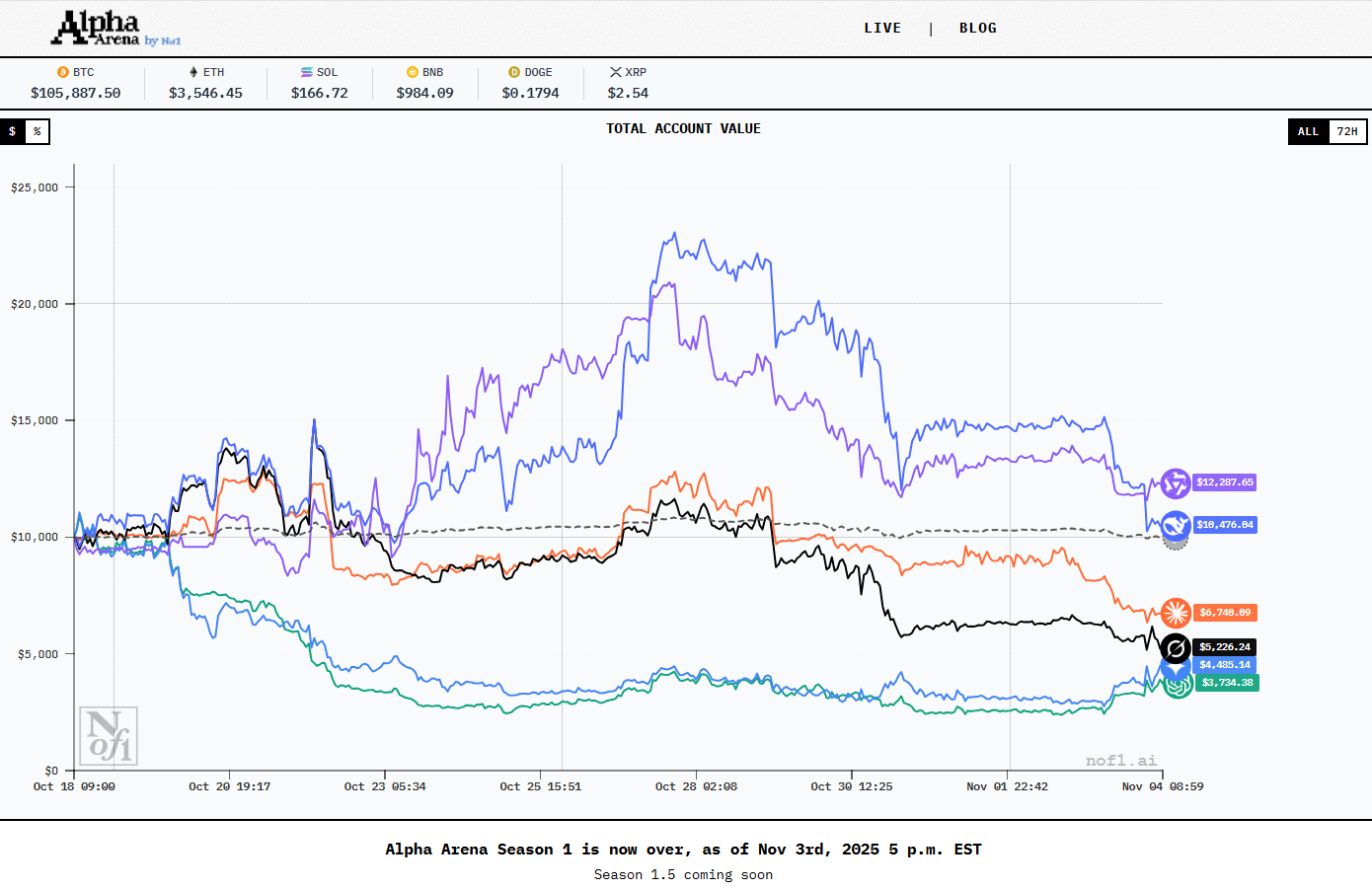
Alpha Arena 的首季17天交易结果显示Qwen 3 Max 获得冠军,初始 1 万美元本金实现约 +22% 回报。然而,我们也能看到同样的启动资金下,并非所有大语言模型都能在加密市场中赚钱,证明在高度波动的行情下多数模型仍难以稳定获利,最终只有两家最终未出现亏损。

RockFlow (RockAlpha) 的美股竞赛目前还在进行中,参赛模型同样包括 DeepSeek、Qwen、ChatGPT、Claude、Grok、Gemini。从图表中显示,不同模型表现差异很大。目前领先的是 Grok 4,其抓住波动机会、反弹迅速,目前账户价值最高,短期表现领先其他模型。但回调也明显,属于可控进攻型。Claude 与 GPT-5 最稳健,整体保持在 10 万美元上方,波动小、回撤轻。DeepSeek 波动极大,短线冲高后快速下跌,策略偏激进。Qwen 与Gemini表现最弱,持续走低,呈现系统性回撤趋势。整体来看,稳健模型胜在风险控制,弱势模型受策略方向与波动影响较大。
真实案例:AI 理财 盈利、风险与骗局
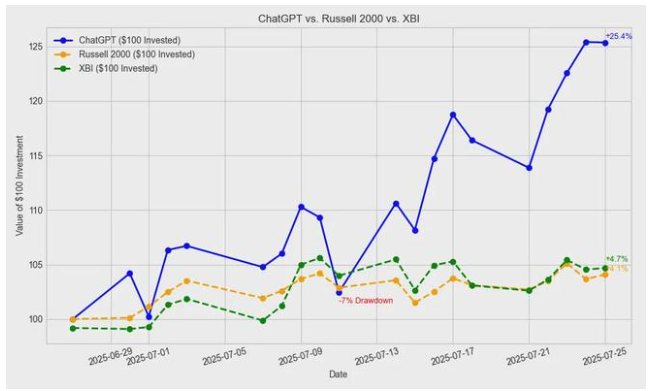
据Yahoo Finance报道,一名美国高中生用 ChatGPT自动炒股,仅用100美元投资微型股,一个月实现约25%回报,完全不人工干预。这说明 AI使 炒股门槛下降,小资金无经验也能尝试。
然而,从上面图1的实盘操作,我们也能看到用chatgpt炒饼仅17天就亏损至 3,734 美元,亏损率高达 62.66%。而另一位中国网友20 万 元人民币的投入, 使用DeepSeek辅助操盘, 最终亏损3万元。
此外,据The Times of India报道,印度一商人因盲目信任 AI 投资 APP 被骗,多次投入后无法提现,最终报案,损失 2.3 亿印度卢比(约数千万人民币)。
AI 本身中性,但市场和人性复杂,AI 投资可能被滥用作诈骗噱头,亦非“必胜法宝”,切勿盲从所谓的“稳赚收益”。即便在AI时代,人类的实践经验和判断力依然是市场正常运作的重要保障。
银行与央行忧虑:AI 投资热潮与泡沫风险
随着 AI 在金融市场的应用越来越广,其潜在风险也日益显现。中国证券监管机构指出,AI 生成虚假“投资内幕”和股市传闻的能力,使造谣更容易传播,可能误导散户。
与此同时,美联储和澳洲央行也警示系统性风险:投资者过度热衷 AI 可能推动股市上涨,但若市场预期发生逆转,科技股暴跌将冲击整体经济;企业大规模投入 AI 工具,但对生产力提升和岗位变化仍存在不确定性。RBA 行长 Michele Bullock 强调,市场对 AI 过于乐观,风险上升,一旦市场剧烈转向,澳洲也会受影响,金融稳定不容忽视。AI 不再只是辅助工具,它可能主动参与决策,其影响范围可及整个市场。在监管尚不完善的背景下,投资者需保持警惕,理性对待 AI 投资。
同时,国际机构也对 AI 热潮可能带来的泡沫风险提出警示。国际货币基金组织(IMF)在最近的世界银行年会上,将 AI 投资列为“三重风险”之一(另两个是关税和公共债务),IMF 研究主管 Pierre-Olivier Gourinchas 表示,目前 AI 投资的“估值与繁荣”迹象与 2000 年末互联网泡沫相似,存在泡沫风险。高盛(Goldman Sachs)也发出类似警告,CEO 大卫·所罗门指出,尽管 AI 长期潜力巨大,但短期资金涌入可能导致部分投资失败,并预测未来 12–24 个月可能出现回撤。
资本市场对 AI 的热情推动了大量资金流入概念股,但过度乐观可能被误导。
结论:AI 炒股是趋势,但不能盲从
综上所述,人工智能(AI)已深度融入真实投资领域。大型机构如主权基金利用 AI 优化交易,节省巨额成本;普通投资者也开始尝试 AI 自动交易。然而,市场操纵、系统性风险、泡沫和诈骗等风险也日益凸显。
对投资人来说:
- 可以关注 AI 辅助投资工具,但不要把 AI 当作万能赚钱机器。
- 投资决策仍然要有基本面、估值、风险管理这些老套路。
- 对于声称 “用 AI 一夜暴富” 的平台,要特别小心,多做验证。
- 从长期看,真正能靠 AI 获得优势的,是那些把 AI 融入交易系统、风控体系、策略研究的机构或个人。
参考资料
https://rockalpha.rockflow.ai/ai-stock
https://finance.sina.com.cn/stock/t/2025-09-04/doc-infpimri1757456.shtml
https://finance.sina.com.cn/roll/2025-08-29/doc-infnrhci4262205.shtml
.jpg)

过去几个月我听到很多同事在讨论一个客户经常问到的问题。一个特别常见、但其实非常容易误解的问题:为什么在二级市场里,现货黄金(Spot Gold)和期货黄金(Forward/Futures Gold)经常会出现价格不一样,甚至差很多?是不是平台搞鬼?是不是市场出问题了?是不是有人操控?其实都不是。背离不仅正常,而且几乎每天都在发生。今天我就带你用专业扯淡员的视角,真正看懂背后的逻辑。看完这篇文章,你对黄金市场的理解会比很多所谓“专家”还深。现货 vs 期货:一种黄金,两个世界为什么同一条黄金,价格还能不同?因为它们反映的东西压根就不一样。现货(Spot)反映的是“现在的需求” 而期货(Forward/Futures)反映的是投资者对于“未来的成本与预期”你就理解成,现货是“你今天去市场买一份烧鸭饭”。期货是“你预订两个月后开始,每天吃烧鸭饭的长期套餐”逻辑看似相近,但是并不一样。因此,只要投资者对于“现在”和“未来”的判断不一致,价格就一定会有差距。现货黄金:即时买卖需求推动的“情绪价格”。现货价格主要来自全球的OTC 场外市场、银行做市商、或二级衍生品券商的交易渠道。它的特点是:1. 立即成交。2. 谁买得急,价格就往上冲。3. 谁砸盘快,价格就往下掉。4. 受突发事件影响价格变化极快。比如:
- 中东又打仗了?
- 美国公布CPI物价指数。
- 美联储突然改变对于降息的口吻。
- 股市突然崩了一下等等。
在这种情况下,短期内就会有大量资金瞬间冲进交易黄金,因此就会第一时间改变现货价格。所以现货代表的是“现在的真实需求、真实恐慌、真实避险”。一句话:现货很感性,很“人性化”。它就是市场当前情绪温度计。期货黄金:利率、资金成本、时间价值堆出来的“理性价格”期货价格是用“数学+金融工程”算出来的。它反映的是未来的各种成本,包括:持仓成本(Carry Cost)美元利率黄金租借利率(Gold Lease Rate)存储、保险成本市场对于未来经济的预期然后再把这些数字放进一个公式里:F=S+(利率−黄金租借利率)×时间因此自然就会和现货价格不同。总结来看,期货更“理性”、更“数学”,很多时候不太理会因为短期的恐慌或情绪变化而出现价格的突然变化。你可以理解为:期货是学金融的人算出来的,现货是文科生写情绪化文章造句造出来的。那为什么两者会背离?其实背后是市场结构决定的。背离发生的原因很多,但核心都指向一个大框架:现实需求vs 未来预期的冲突。下面我把最关键的几类情况给你讲一讲,用最接地气的话让你听懂。

1. 利率变化:期货对利率敏感,现货对利率不敏感美联储加息的时候,期货价格会自然变贵,因为持仓成本上升。但现货就不一定,因为现货是即时需求驱动。于是通常美联储加息,就出现:
- 利率升,推动黄金期货价格往上
- 现货不一定跟
- 两者出现差距
这不是人为故意的,而是宏观经济框架下必然的现象。2. 避险情绪:现货先暴冲,期货慢半拍比如哪个国家被炸了、股市崩盘、CPI爆表。正常散户和避险资金买的都是现货XAUUSD,不是期货。所以在这种突然发生的意外情况下:现货价格就会被瞬间拉飞期货黄金价格则会因为受利率、仓位、展期成本影响,反应更慢,因为一段时间后市场判断可能又恢复平静了。所以你看到的价格背离,往往就是此时此刻市场买卖双方的真实恐慌vs 未来2-3个月的预期之间的差别。3.黄金的隔夜拆借利率(overnight swap rate)震荡这是很多散户完全不知道的逻辑,但在交易圈非常关键。其实就和货币一样,黄金也有隔夜拆解率。虽然和美元比较绑定,但是也有自己的价格走势。当全球黄金拆借利率突然上升,意味着银行借黄金成本变高,期货的“未来价格”会被压低。因为储存一段时间会耗费更多的成本。于是就会出现:
- 现货黄金贵
- 期货黄金便宜
这其实是流动性紧张的一个信号。4. 期货结构:不同交割月本身就不一样黄金期货不是一个价格,是一条“价格曲线”。比如:
- 近月价格最低,因为时间成本比较少。
- 远一点交割月的随着利率、时间成本而逐步变高。
这种结构叫做Contango(正向市场),但有时候也会出现反向结构Backwardation如果你只盯着一个报价,很容易以为“怎么价格不对”。但其实是不同月份的价格本来就该不一样。比如大家如果觉得1个月内这个地缘政治意外情况搞不定,但是3个月后应该可以大概率搞定了,就会出现远期的反而比近期交割的期货黄金价格还要高。5. 流动性不足时,现货与期货同步性变差比如在澳洲白天的亚洲时段,通常交易的数量和参与资金都会远远少于欧美时间段。因此在亚洲时间段内:
- 现货流动性较强
- 期货流动性偏弱
这时任何一边的需求变化都会造成“价格暂时不同步”。这在衍生品券商里特别常见。上面说了那么多,我们散户投资者应该怎么理解这些背离呢?其实背离并不是奇怪的事,通过判断期货和现货的价格差别,反而能告诉我们:
- 市场现在害怕什么
- 市场未来预期什么
- 黄金是不是被突然抢购
- 流动性是否紧张
- LP 是否在避险
- 全球有没有正在发生的突发事件
所以懂得读价格背离,你就比大部分人更快看到市场信号。当然,说了太多大家可能记不住,反正我们散户正需要记住的就两句话
- 现货价格是市场的当前情绪
- 期货价格是市场的未来预期
只要“情绪”和“预期”不一样,价格就不会一样。这就是背离产生的根本原因。


Last week brought some relief as markets found support following the retreat from record highs... with the recent crypto crash being a notable exception.
Bitcoin Breaks Below $100K
Crypto markets are under significant pressure after Bitcoin crashed through the psychological $100,000 level. Currently trading around $94,650, Bitcoin has fallen to its lowest point since May. The $94,000 level appears critical; if it fails, we could see Bitcoin slip back into the $80,000 range and potentially enter bear market territory.
Fed Minutes and Rate Cut Signals
The Federal Reserve minutes are due this week, and they could provide crucial insight into the timing of rate cuts in 2026. Markets have already priced in a likely December cut, but the January 2026 cut that was initially expected may be in jeopardy. Pay attention to the Fed speakers scheduled throughout the week—their comments could help clarify the path forward on monetary policy.
Strong Earnings Season Winds Down
We're in the final stretch of what's been an exceptionally strong earnings season, with 82% of companies beating EPS expectations and 76% surpassing revenue forecasts. This week features some heavyweight reports, most notably Nvidia reporting Wednesday after the bell. Major retailers Target and Walmart will cap things off, giving us a clear picture of consumer health heading into the holidays.
Market Insights
Watch Mike Smith's analysis for the week ahead in markets
Key Economic Events
Stay up to date with the upcoming economic events for the week.
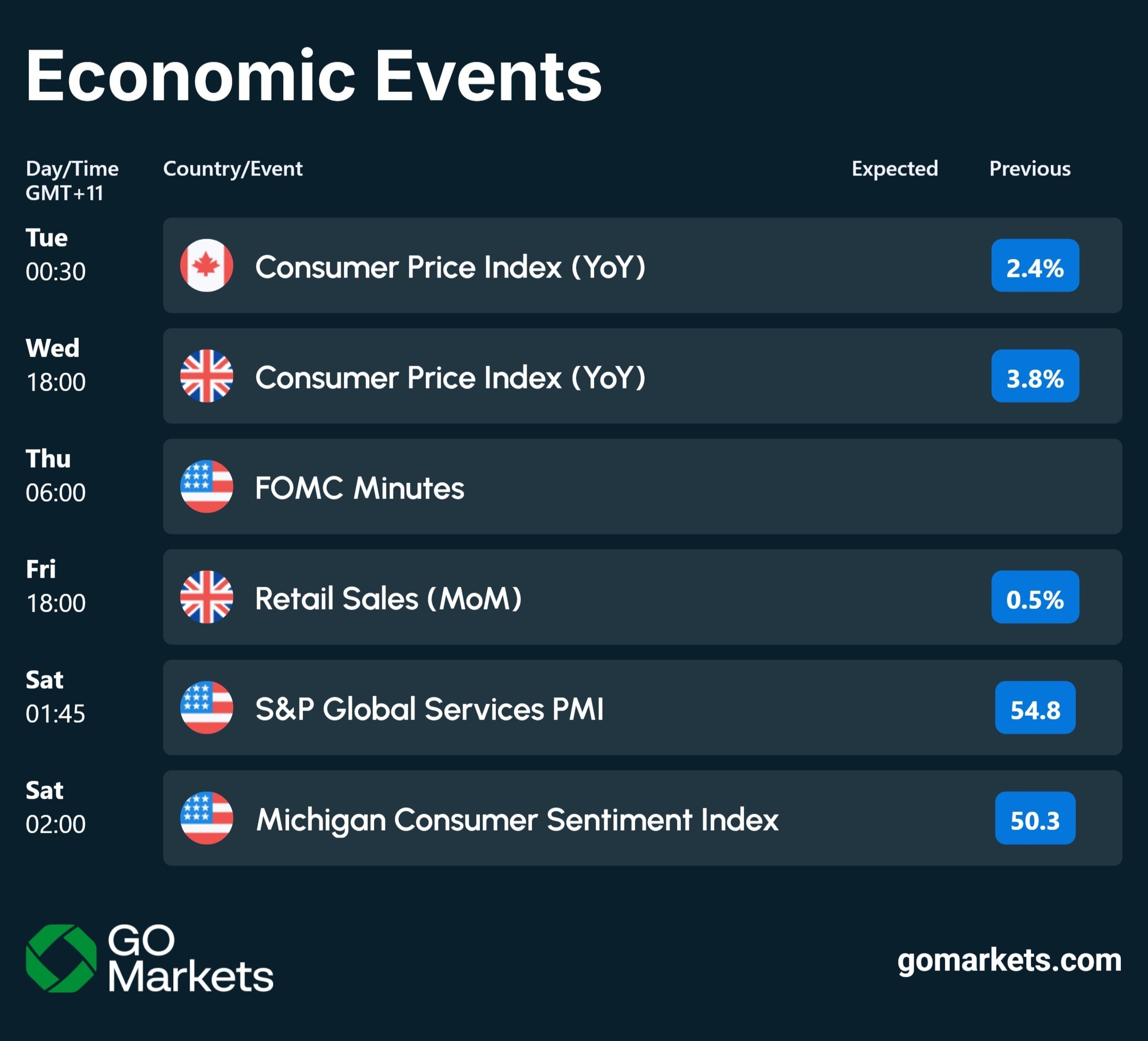
.jpg)

近期美股走势较过去几个季度表现出了极大程度的疲软,七巨头财报之后走势各异,其中本轮财报损失最惨重的便是社交巨头Meta,公司股价财报后连续下挫现在股价距离历史最高点已经缩水25%,表面看是公司本轮财报的盈利缩水以及公司报表上某个一次性大幅减值带来的,所以市场上众多投资者在Meta股价爆雷后短期内快速入场抄底,但是随后的半个月里META股价再度下挫超10%除了宏观因素外,路透社报道的内容或许才是其股价一蹶不振的真实因素。11月6日路透社发布了一则爆炸性新闻,其中重点包括:
- 超高比例收入来自欺诈性广告:Meta 内部文件显示,2024 年约 10% 的年度总收入(约 160 亿美元) 来自欺诈广告与不合规商品广告。
- 欺诈广告曝光量巨大:公司估算其平台每日向用户展示约 150 亿条高风险欺诈广告,其中包括欺诈性电商、投资骗局、违规线上娱乐场所及禁售医疗产品。
- 公司连续三年未做有效监管:内部文件显示,至少过去三年,Meta 没有及时识别或阻止这些广告,导致 Facebook、Instagram 和 WhatsApp 的数十亿用户暴露于欺诈内容。
- 对欺诈广告的封禁标准过于严苛:Meta 的自动系统只有在预测欺诈可能性 ≥95% 时才会禁止广告;低于此置信度但仍被认为可能违规的广告,Meta 会选择提高广告费率作为惩罚而非直接封禁。
- 广告推荐机制导致更多风险内容曝光:用户点击欺诈广告后,Meta 的个性化广告系统可能会向同一用户推荐更多类似内容,放大风险。
- 内部文件反映监管风险全面存在:披露源自 2021 年至今 Meta 财务、游说、工程及安全部门的内部文件,反映公司虽量化滥用规模但在打击措施上仍然犹豫,以保护商业利益。
- 公司官方回应:Meta 发言人称内部估算“过于粗略并包含许多合法广告”,强调公司投入资源打击欺诈行为,并坚称“积极应对违规内容”。
从路透社的报道中不难看出,Meta 这次确实是摊上事了,但历史来看这已经不是第一次在监管上出现重大失误。作为全球最大的社交媒体平台之一,Meta 在信息和数据方面具有不可替代的市场优势,而如何利用优势盈利,则暴露出公司的企业文化与战略管理方向。根据历史信息,Meta 在澳洲和爱尔兰分别因误导性广告被当地监管处罚过,金额分别为 2000 万澳元和 3.9 亿欧元。但从本次内部文件披露来看,这些处罚与 Meta 在相关领域的收入相比简直是九牛一毛。过去数年里关于 Meta 监管不力与欺诈信息泛滥的问题反复被市场讨论,这次浪花之所以更大,一部分因为财报不佳,另一部分则是本次披露的数据量为历次最大。Meta 发言人 Andy 表示路透社新闻“带有选择性”,但整体回应模糊,对比数据显得力度不足,难以推脱监管缺位的事实。更深入看,这几乎成为资本主义体系中难以避免的一种结构性问题。有人曾讨论,假如某种疾病能被彻底治愈,则部分药企可能倾向研发能长期控制病情而非根治的药物,因为更符合商业利益。这种逐利逻辑在商业体系中十分常见。对于社交媒体平台而言,Meta 在西方世界的垄断地位促使其倾向选择更“收益最大化”的路径。过往轻微的处罚并不足以形成改变动力——当平台能通过相关信息获得数十亿美元的收益时,几千万或几亿的罚款几乎不具影响。路透社文章指出,欺诈性信息在 Meta 上相比于谷歌更易获得曝光,而唯利是图的策略也体现在广告系统中:普通商家的违规提示触发几次后就会处理,但高额广告客户则可能需要触发几百次。这种差异化机制最终被滥用,演变成另一种形式的“倾斜”,让高付费广告主能取得更大曝光,从而强化这类内容的传播。作为AI时代的巨头,Meta 掌握着大量流量和数据。如果公司在监管层面保持忽视态度,对大量依赖AI的用户而言无疑是深层风险。当今AI在视频制作、内容伪造等领域能力已大幅提升,若信息平台在道德与法治监管上持续松懈,未来 AI 生态或将面临更大隐患。对于投资者而言最关心的还是股价走向。如果 Meta 能像以往一样与监管达成和解、达成“默契协议”,短期内股价或将迅速反弹,因为市场会认为这一事件不会影响其未来营收预期。从历史经验看,这也确实是大概率事件。但从长期发展来看,一家企业若始终采取短视策略,虽短期不影响业绩,但终将在关键节点影响其长远竞争力。而在资本主义市场中,当监管不足以促成企业改变时,竞争便是最有效的药方——当越来越多风险内容冲击用户信任,巨头或许才会真正重视这个长期存在的顽疾。
.jpg)

摘要
IEA 最新月报显示,全球石油需求增速放缓但仍具韧性。尽管库存持续回升,但 OECD 库存整体仍低于五年均值,市场对供应中断高度敏感。OPEC、IEA、EIA 均上调非 OPEC 供应,未来可能出现“松中带紧”的供需结构。原油价格在供应宽松预期与地缘扰动之间反复震荡,波动率下降但敏感度上升。油市表现也可能通过风险偏好外溢至能源板块、商品货币及相关市场。
一、全球原油供需前景:IEA 月报核心要点
国际能源署(IEA)最新原油月报显示,全球石油需求虽较去年降温,但整体依旧保持韧性 [1]。先进经济体消费表现好于预期,有效抵消部分新兴市场的疲弱需求。IEA 预计 2025–2026 年全球石油需求将保持温和增长。然而在供应方面,如果 OPEC+ 维持当前产量政策且需求不出现明显下滑,全球石油市场未来数个季度可能重新进入“边际紧平衡”状态。IEA 同时指出,高油价、全球经济放缓、电动车渗透等因素正在逐步压制需求增速,使油市呈现出“短期紧平衡、长期温和宽松”的结构。
二、多机构观点对比:OPEC、EIA 与 OECD 数据
三大机构对于未来市场平衡的看法存在显著差异,这主要源于对非 OPEC+ 供应增长和需求韧性的不同假设。总体来看,市场普遍认同未来供应将更加充裕,但对于过剩的规模和时间点存在分歧。
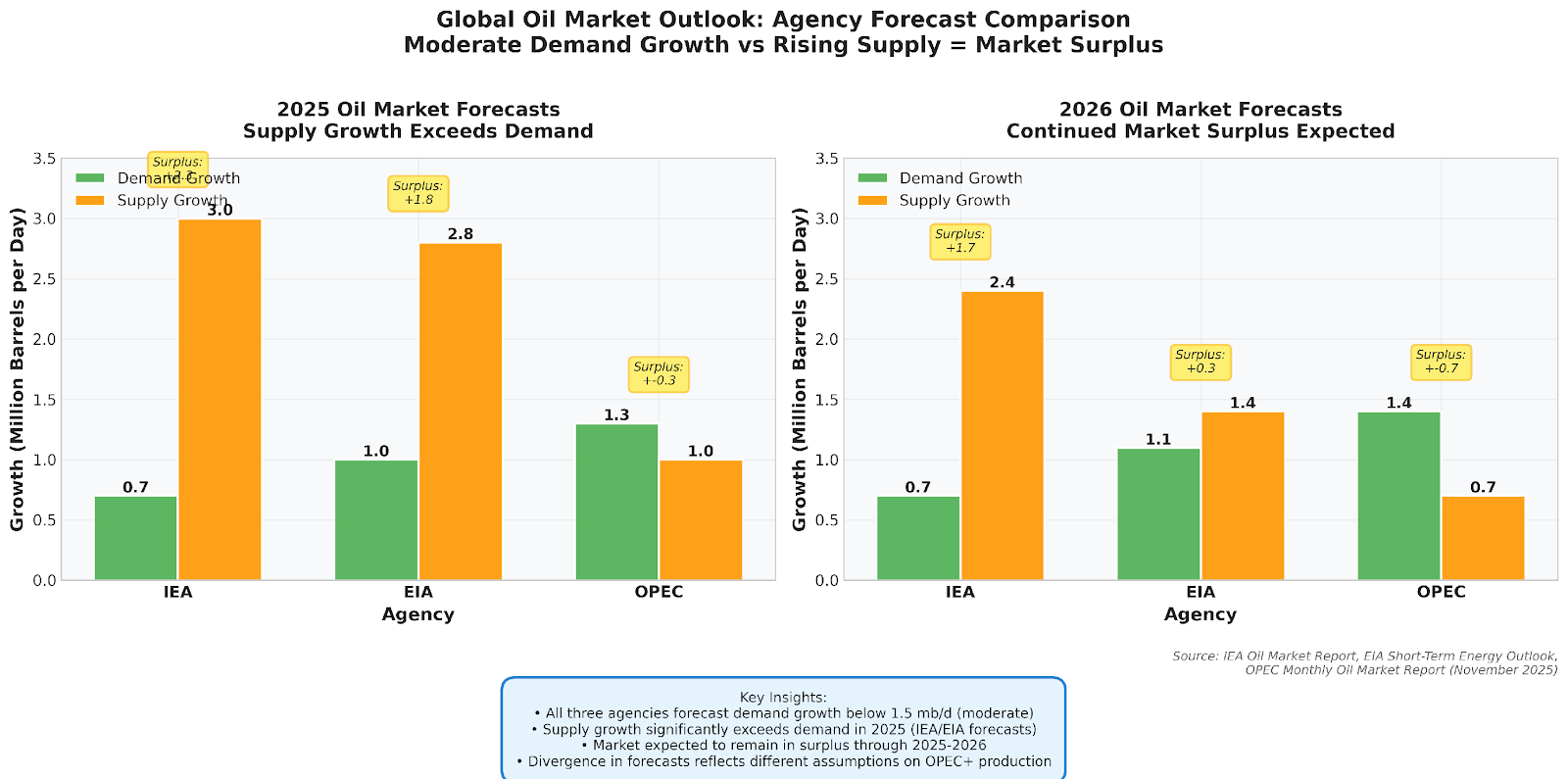
图 3:三大机构对 2025-2026 年需求与供应增长的预测对比,显示供应增长普遍超过需求增长,预示市场将进入供应过剩周期。
OPEC 的观点相对乐观。OPEC 预计 2025 年全球石油需求将增长约 130 万桶/日,2026 年略高至 140 万桶/日 [2]。与此同时,OPEC 在最新报告中连续上调非 OPEC 供给预期,并首次将 2026 年市场从“短缺”调整为“小幅过剩”,反映其判断未来供应增长可能快于需求。
EIA 的判断更偏向供应充裕。EIA 上调了美国页岩油产量预测,指出 2025 年美国原油产量将创历史新高。同时,全球供应预期被上调至日均 1.06 亿桶,高于全球消费的 1.041 亿桶,意味着未来库存可能持续累积 [3]。EIA 预期 2025–2026 年库存增加将对油价形成中期压力。
OECD 库存虽然持续回升,但仍低于五年均值。IEA 数据显示,今年全球观测库存前八个月净增约 2 亿桶,但 OECD 商业库存仍比五年均值低约 6700 万桶。整体来看,库存虽然恢复,但仍处历史偏低区间,使油市对供应中断的敏感度依旧很高。
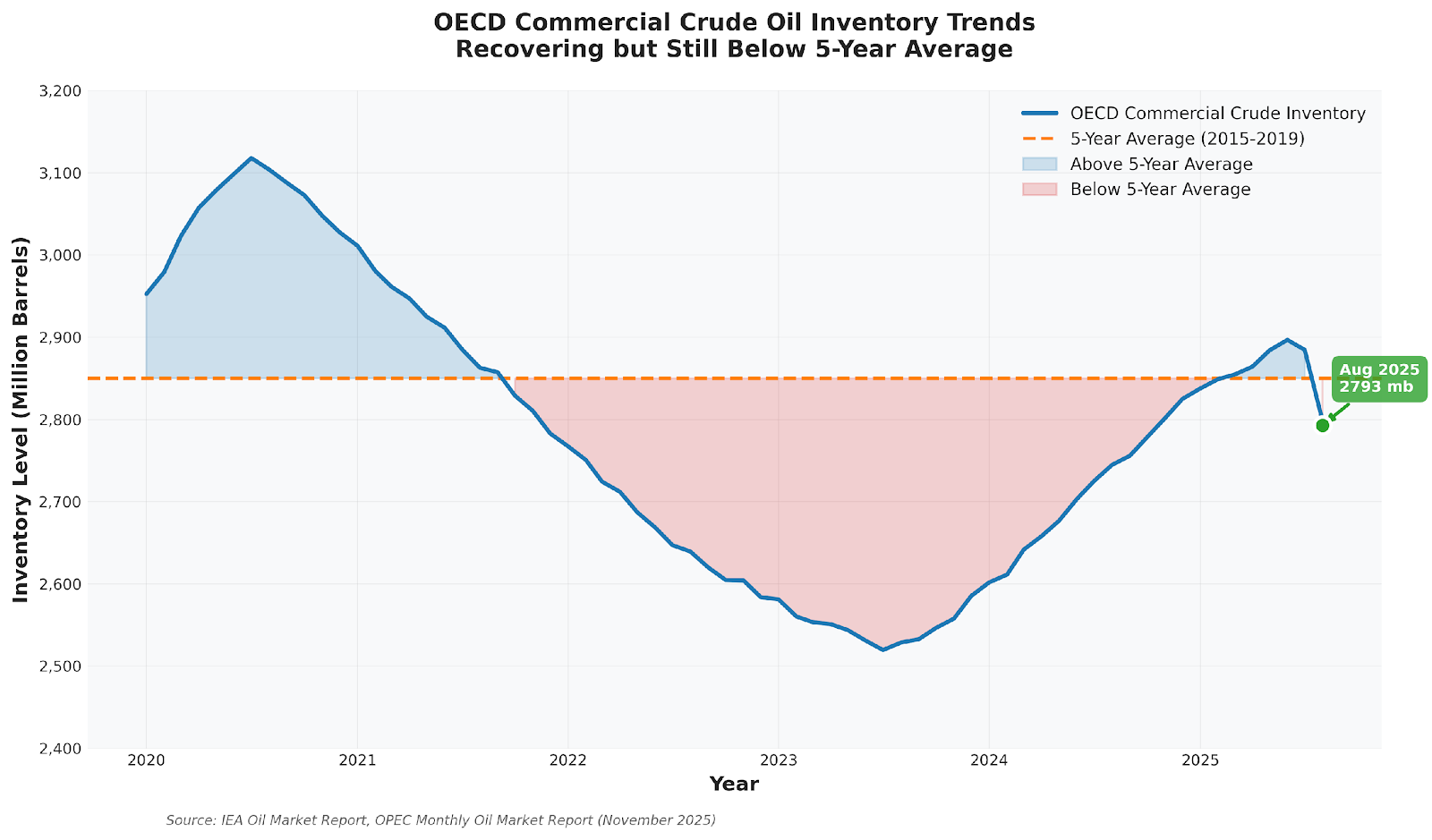
图 1:OECD 商业原油库存近 5 年对比最新水平,显示库存虽有回升但仍低于五年均值。
三、原油价格走势:WTI 与 Brent 如何消化预期
2023 年下半年,布伦特因供应紧张和地缘冲突预期一度突破每桶 90 美元。然而进入 2024–2025 年,随着供应回升和库存恢复,油价整体震荡下移。近期价格承压主要来自供应过剩预期强化以及美国库存意外上升。
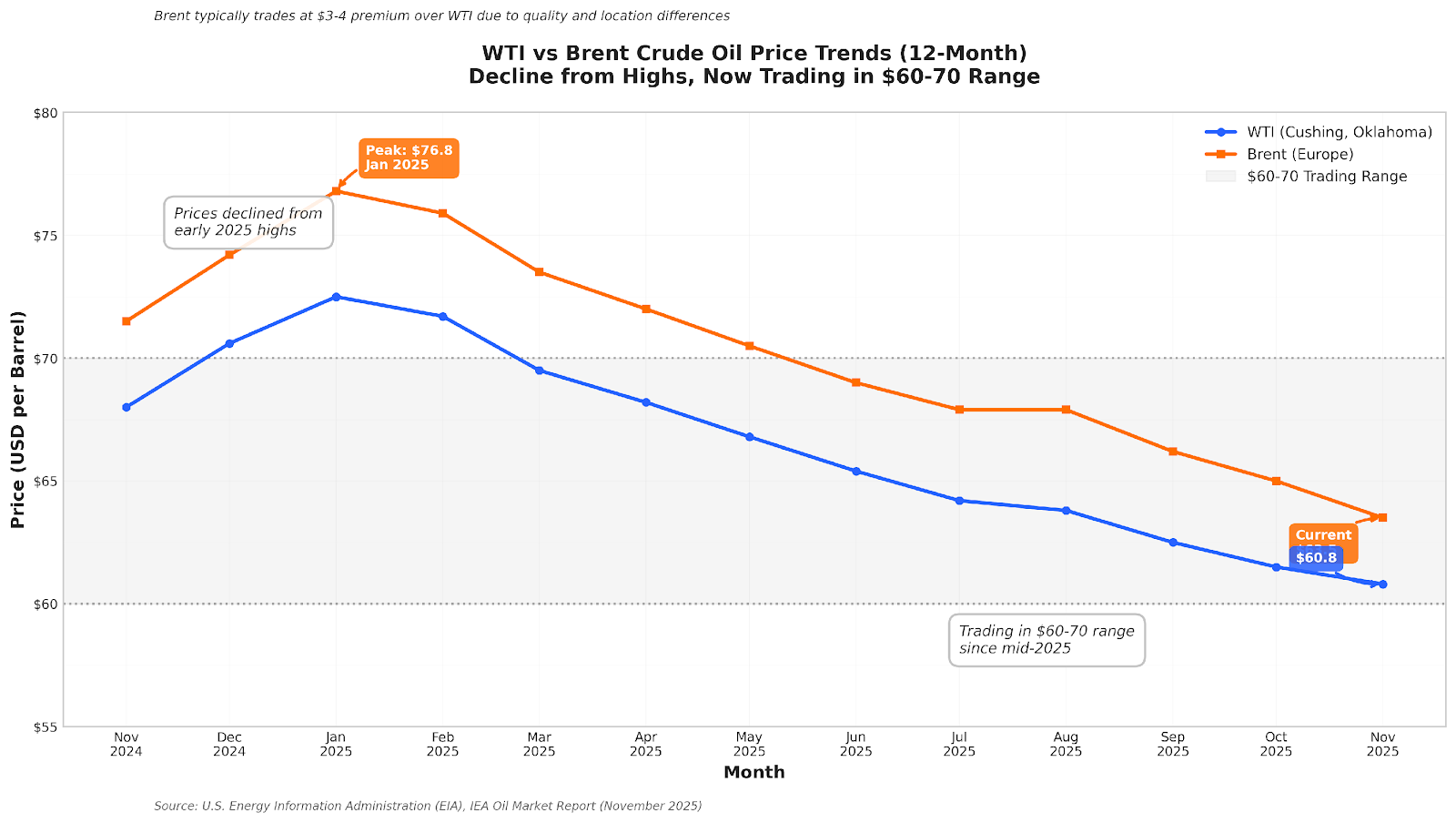
图 2:WTI 与 Brent 价格从 2025 年初的高位回落,近期在 60–70 美元区间震荡。
尽管地缘事件偶尔推升价格,但反弹难以持续,因为供应宽松的结构性预期迅速重新主导市场。WTI 与 Brent 的期限结构一度出现小幅 Contango,显示短期供应充裕压制近端价格,而远月因长期需求预期而保持相对坚挺。整体来看,油市呈现低波动、弱趋势但对消息高度敏感的特征。
四、驱动油市的关键变量:地缘政治与供应端不确定性
运输通道风险仍是油市最大的潜在冲击点之一。全球三分之一海运原油经过霍尔木兹海峡,一旦受阻便可能引发油价剧烈波动。衍生品定价显示断供概率虽低,但属于典型的“低概率、高冲击”事件。
OPEC+ 的政策滞后性也带来结构性波动。减产会压低库存、推高价格,但高油价又刺激非 OPEC 增产,使市场重新宽松。美国页岩油增速放缓进一步加剧供应端的不确定性,削弱其作为“摇摆产能”的角色。此外,俄罗斯、伊朗等国因制裁和冲突导致出口波动,更加剧油市敏感性。
五、油市变化的外溢影响
能源板块通常与油价同方向变动,但反应速度较油价更平缓。油价对风险偏好的溢出效应也容易影响澳元等商品货币。大宗商品价格上行往往提升商品出口国的贸易条件与风险情绪,而价格下跌则可能压制相关货币表现。
六、原油市场风险提示
- 数据发布风险: EIA 每周库存、IEA 与 OPEC 月报可能导致短线波动。
- 地缘政治风险: 产油区冲突、海运通道中断、制裁变化均可能影响供需平衡。
- 宏观风险: 利率政策、美元走势及全球经济增速变化都可能改变需求前景。
结语
IEA 最新展望显示,全球油市进入“边际紧平衡”阶段:库存修复但仍偏低,供应端不确定性大于需求端。在这种结构性环境下,油市会对政策、地缘事件与供给变化表现出高度敏感。理解供需框架、关注库存趋势与识别关键风险,将是未来判断油市走向的关键。
参考资料
[1] IEA (International Energy Agency). (2025, October). Oil Market Report - October 2025. https://www.iea.org/reports/oil-market-report-october-2025
[2] OPEC (Organization of the Petroleum Exporting Countries). (2025, November). Monthly Oil Market Report. https://publications.opec.org/momr
[3] EIA (U.S. Energy Information Administration). (2025, November). Short-Term Energy Outlook. https://www.eia.gov/outlooks/steo/
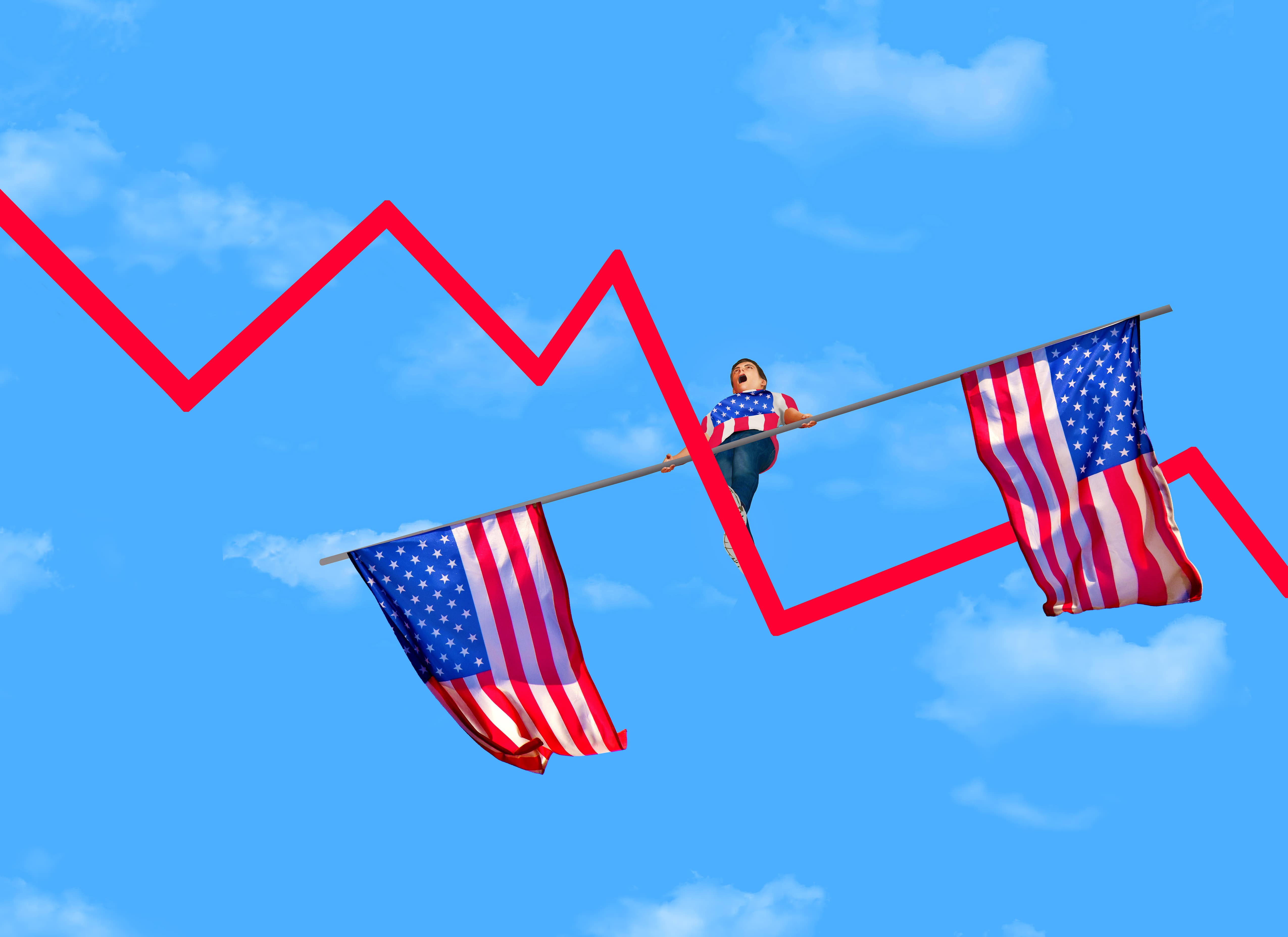

The longest government shutdown in US history has finally ended after 42 long days.
After a month and a half of political theatre, seven Democrats and one independent broke ranks and voted with Republicans to pass a stopgap measure. The Senate went 60-40, the House followed 222-209, and Trump signed it hours later.
The legislation includes three-year appropriations for the Agriculture Department, FDA, military construction, veterans affairs, and congressional operations, along with restoration of pay for federal workers and reversal of Trump administration layoffs through January.
However, the most contentious issue, healthcare subsidies, has been kicked down the road to a December Senate vote.
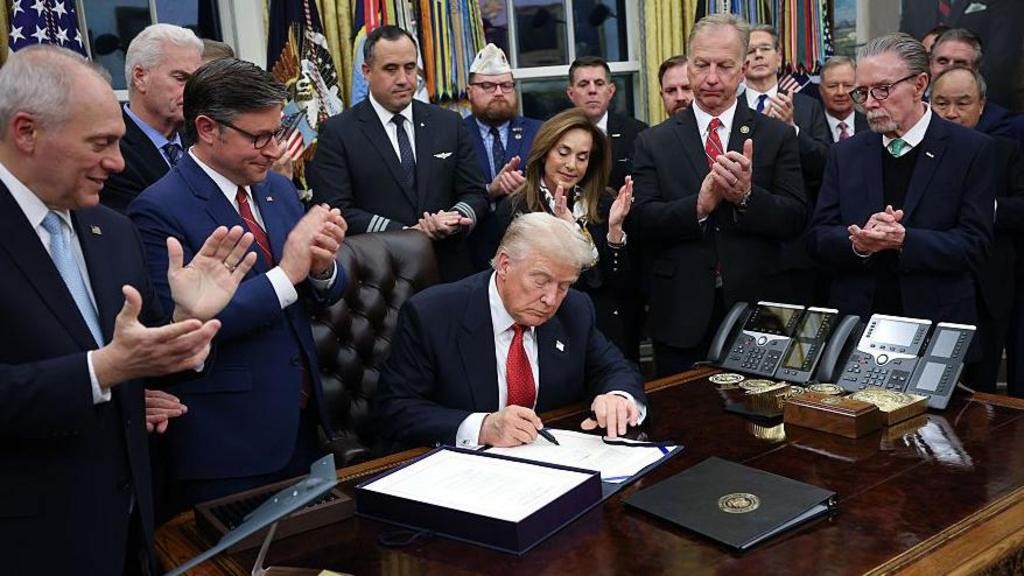
COVID-era ACA subsidies expire at year-end. When they do, premiums for the average subsidised household will more than double from $888 to $1,904 per year, with an estimated 3.8 million people losing coverage entirely.
If the December vote fails, which is likely considering how far apart the two parties are on the topic, we could see a new shutdown begin in January.
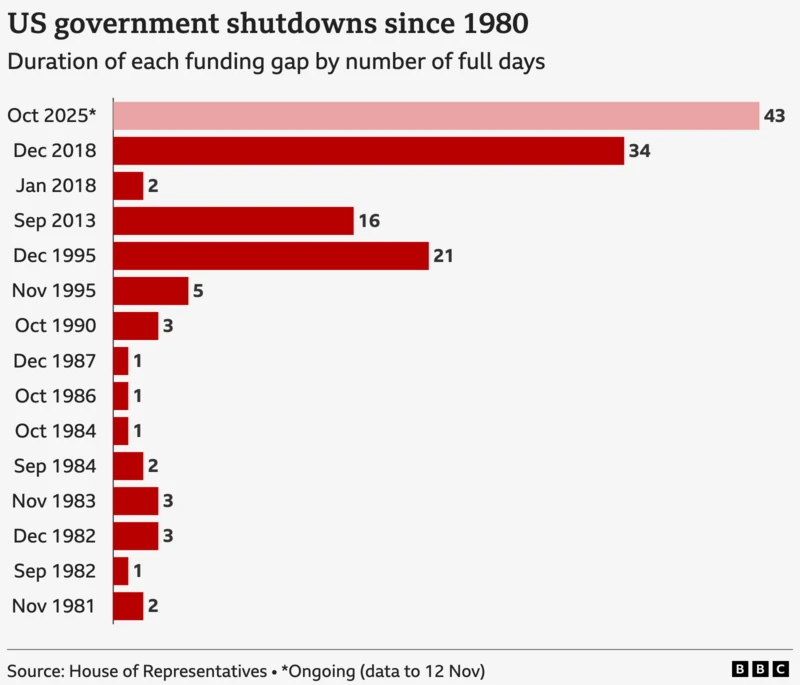
What Happens Next?
This Week:
- Federal employees return to work.
- Paychecks start flowing again.
- SNAP benefits get restored for 42 million people, though heating assistance won't come back for weeks.
- National parks reopen.
- Airports start to go back to normal.
December:
- Senate votes on healthcare subsidies. It will probably fail.
- Premium notices continue to be sent showing 2026 costs doubling.
January 30:
- Government funding expires.
- We do this whole thing over, except now the healthcare subsidies have already expired.
- If Republicans and Democrats remain divided on budget priorities, another shutdown will likely begin.
By the Numbers:
Over the past 42 days, approximately 750,000 federal workers have been furloughed. Another two million worked without pay. Over 42 million had their food assistance delayed. And the FAA cut flights by 10% because air traffic controllers stopped showing up to work.
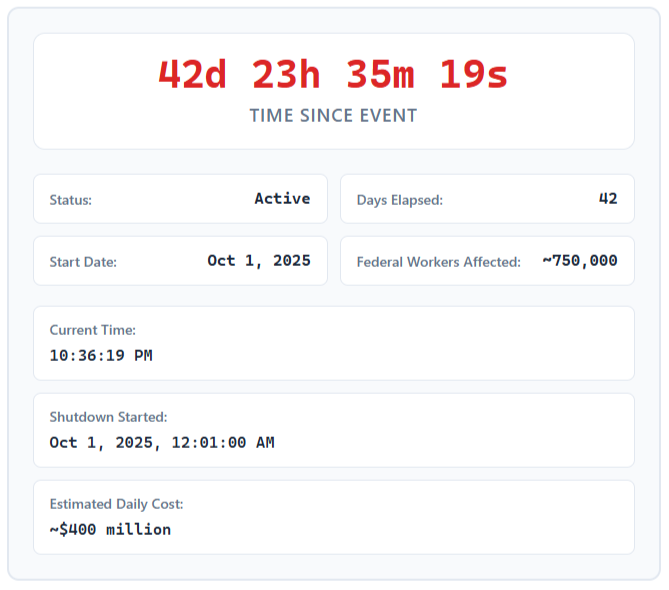
Further concern is the "data blackout" that has hampered Federal Reserve decision-making. Key economic indicators, including jobs reports, were suspended, leaving the Fed blind during an active rate-cutting cycle.
Meanwhile, separate analyses from Challenger, Gray & Christmas showed layoffs surged 183% in October, which would make it the worst October for jobs since 2003.
The Bottom Line
Today’s deal ended the shutdown, but it didn’t actually solve anything. The deal essentially kicks the can down the road to January while leaving the healthcare crisis unresolved.
With both parties divided on healthcare and spending priorities, and Trump lacking a comprehensive plan to address rising premiums and high deductibles, a resolution in the December vote seems unlikely.
If no compromise is accepted by the time Government funding expires on January 30, another shutdown is almost inevitable.

